
Visit Shrines
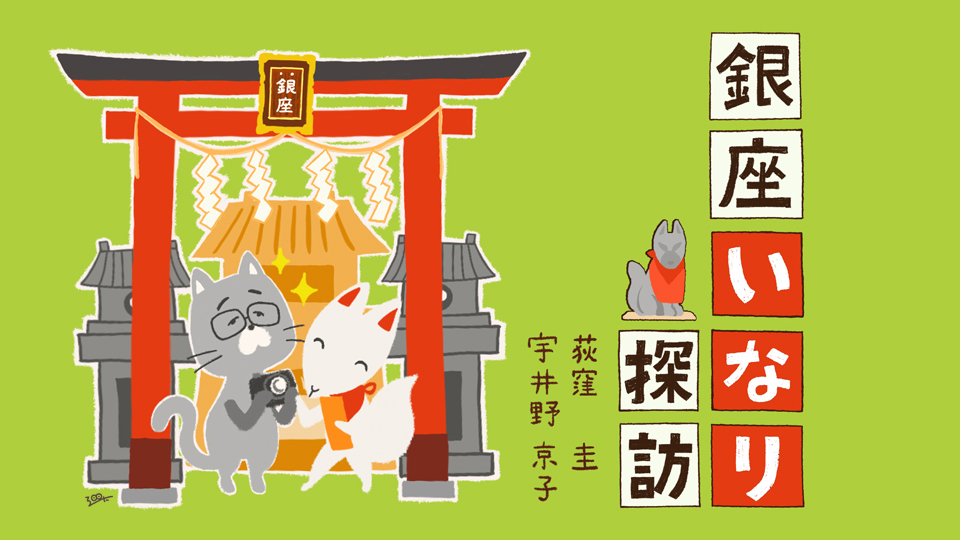
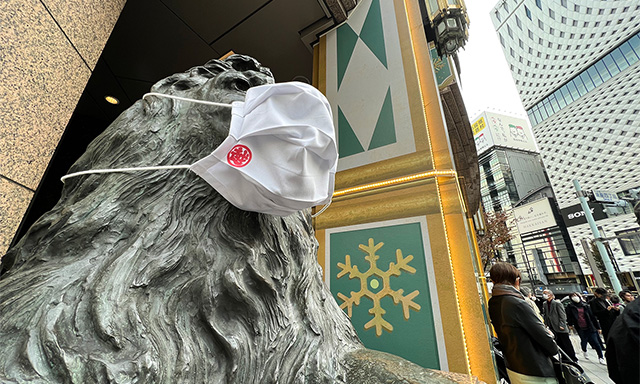
Reflecting the times, the lion statue was also wearing a mask especially made by Mitsukoshi.
- Ogikubo
- We have arrived at the Ginza 4-chome intersection – the heart of Ginza that first comes to everyone’s mind when they think of Ginza..
- Uino
- Yes, this spot is symbolic of Ginza. And Ginza Mitsukoshi is Ginza 4-chome’s landmark. It is also the very place we are going to visit today.
- Ogikubo
- So, our destination is the rooftop of the department store. I have come here so many times in the past and I had never realized that it says “Ginza Shusse Jizoson” in the entrance. Do they worship a Jizo (Ksitigarbha) here?
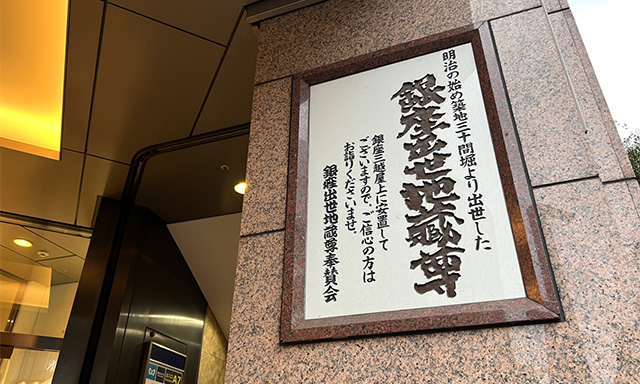
Legends say that it was promoted (“shusse”) from Tsukiji Sanjusangenbori.
- Uino
- That’s right.
- Ogikubo
- Usually, Jizo statues stand on intersections or in the entrance of a village. Indeed, this intersection is old, but Jizo statues are not often found on the rooftop.
- Uino
- The Jizo (Ksitigarbha) is usually known as the form of Buddha that is caring and saves children on the riverbank of the Sanzu-no-kawa River between this world and afterlife. But in this case, a rather serious word “shusse (promotion)” is associated with “Jizo.” Isn’t it bewildering?
- Ogikubo
- We are familiar with the Jizo form of Buddha in our daily lives and therefore, people have made various wishes in accordance with the times or local circumstance, believing the Jizo would answer their prayers. Hence, some Jizo statues have challenged with many unique experiences – being covered in salt, powdered in white, or tied up with rope, for example. One shocking story is the one about the “Gankake Jizo” in Nakano-ku. There are two Jizo statues – one tall and one small – standing side by side. It is said that if a person with a wish comes to the Jizo statues in white costume and pushes the smaller statue down as he/she makes his/her wish, the larger Jizo statue will grant the wish in the hope of saving the smaller statue. It was customary return when the wish came true to say thanks and pull the smaller Jizo statue up. Isn’t that shocking?
- Uino
- That is one appalling system – taking advantage of the friendship between two Jizo statues to grant one’s wish. It is human arrogance.
- Ogikubo
- And now as we chat, we have arrived at the rooftop. The rooftops of department stores have evolved from miniature amusement parks where children used to play in the Showa period to a place to relax.
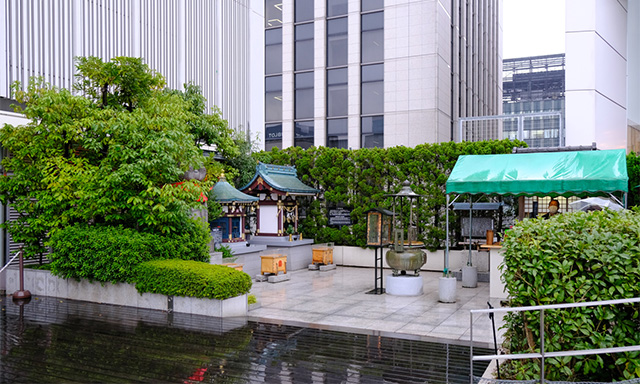
Unfortunately, it was a rainy day, but the shrine could be seen in the distance.
- Uino
- The Jizo statues and Mimeguri Jinja can be found in the back. It is well known that Mimeguri Shrine is worshiped by Mitsukoshi Department Store.
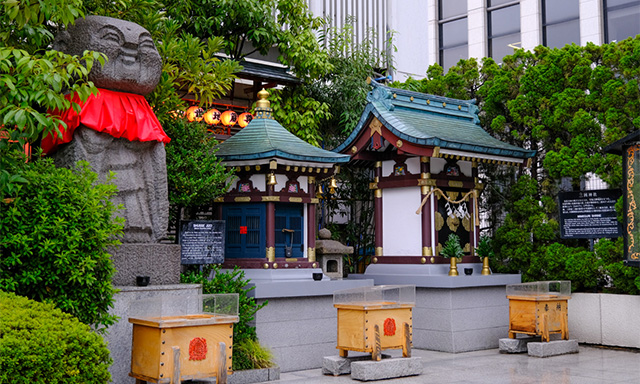
- Ogikubo
- That is right. Mimeguri Jinja is an Inari shrine; and therefore, this visit fully matches the concept of “Visit Ginza’s Inari Shrines” series. By the way, the name is “Mimeguri Jinja.” At first, you wonder if it reads, “Mitsu Jinja” or “Mii Jinja,” but the right way to read it is “Mimeguri”.
- Uino
- What is the story behind Mimeguri Jinja?
- Ogikubo
- It was located in Mukojima. It was an old Inari Shrine located on the other side of Sumidagawa River, looking from Matsuchi-yama. It often appears in Ukiyoe prints from the Edo period.
- Uino
- The name resembles “Mitsui” but it has a close relation with Mitsukoshi?
- Ogikubo
- Well, Mitsukoshi was originally Mitsui Echigoya. But the shrine itself is older. It is said to have been built in the Heian period. The story goes that when a Buddhist priest from Mii-dera Shrine located in Oumi renovated the shrine during the Muromachi period, a white fox walked around the image of an old man on a white fox three times and disappeared. This is where the name, “Mimeguri (three rounds) Inari” comes from. At this point, the shrine had no relation with the Mitsui family. However, when the Mitsui family extended its business to Edo city during the Edo period, they found that the name Mimeguri sounded similar to Mitsui and that the character for “meguri: 囲” looked as if it protected the Mitsui family. Hence, they decided to make the shrine the guardian of the Mitsui family during the Kyoho years of the mid-Edo period.
- Uino
- That is quite interesting. So the name of the shrine was first.
- Ogikubo
- On the premises, you can find the rare triangular Torii gate moved from the Mitsui family house and the lion statues that used to stand in front of the Ikebukuro Mitsukoshi department store before it closed. The adorable fox with droopy eyes offered by the Mitsui Echigoya during the Edo period is another must-see.
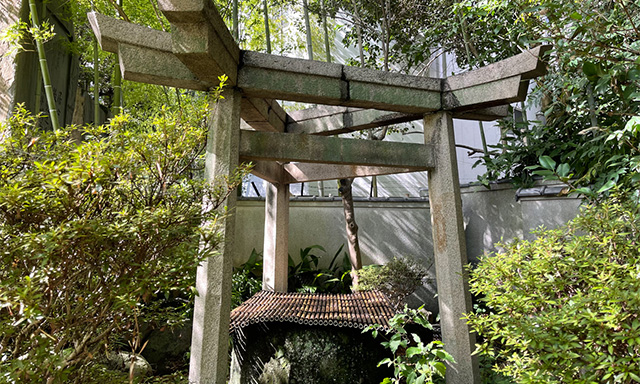
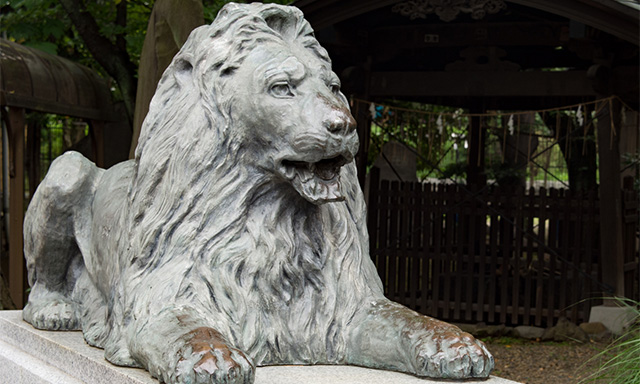
now guard Mimeguri Shrine as guardian lions.
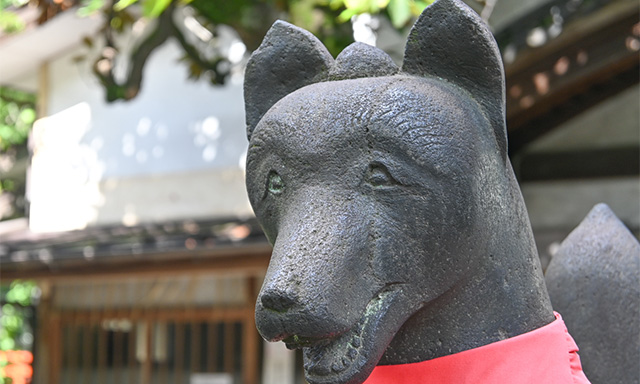
- Uino
- They look like those animal friends that appear in fairy tales. They are almost too cute to be servants of a guardian shrine of a large business. So, since it is the guardian god of the Mitsui family, there is a shrine at Mitsukoshi, too.
- Ogikubo
- Yes, but I am also curious about the Jizo statue standing beside Mimeguri Shrine. This is the Shusse Jizo.
- Uino
- The large Jizo statue on the left was made based on the principal image, which is enshrined in the back of the alter here.
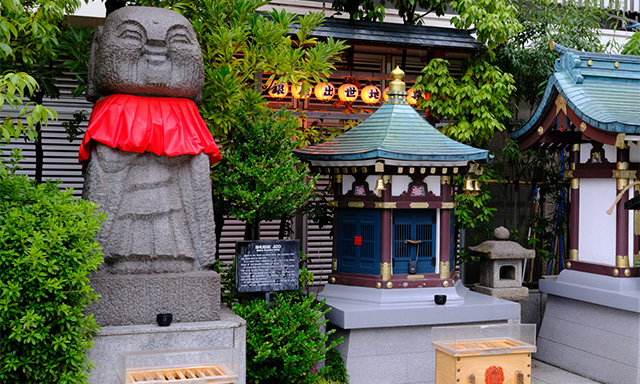
- Ogikubo
- It strikes me that the Jizo statue is larger than the hall beside it in which the principal image is enshrined. It has a unique expression. Is it like a replica – an enlarged copy?
- Uino
- Rather than being a replica, it seems to be more like an alter ego of the principle image. The old Buddhist statue has been exposed to dirt and water across many years. Moreover, Ginza has experienced the Great Kanto Earthquake and air raids; and therefore, the principal image must have been lost or damaged along the way. Hence, they must have newly carved the image out of stone.
- Ogikubo
- What is the origin of this Jizo statue? Was it standing in the intersection of Ginza 4-chome?
- Uino
- It seems to have first appeared from Sanjikkenbori during the Meiji period when they were conducting bank protection works. The statue was placed on open land in Ginza 4-chome. They say that festivals were also held around it up to the Great Kanto Earthquake.
- Ogikubo
- The Meiji period… Look, you can find “Shusse Jizo” marked on tis map from the late Meiji period. It must have been worshiped by a wide range of people for its name to be written out on a map.
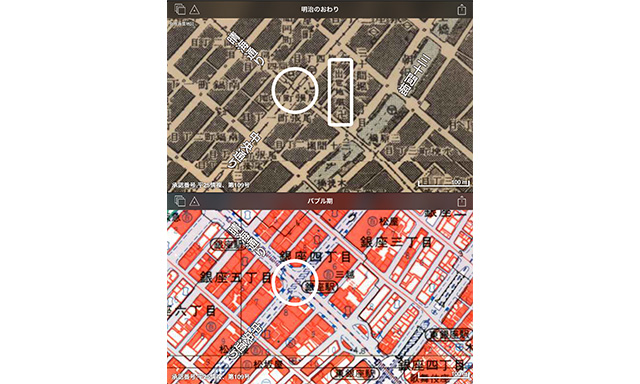
The map on the top is from the late Meiji period. The bottom map is from the time of the bubble economy. The Ginza 4-chome intersection is marked with a white circle.
In the white box, it says “Shusse Jizo”.
- You are right.
- Right next to Sanjusangebori, along Harumi-dori, it says “Shusse Jizo”.
- Ogikubo
- According to the history of the Shusse Jizoson, they placed it on the rooftop of Ginza Mitsukoshi in 1968 (Showa 43) when it was fully renovated. It is often said that the idea of a Jizo statue that had long been standing by the road climbed up to the rooftop of a major department store brought people to call it “Shusse Jizo,” but now I see that it has been known by that name from farther back.
- Uino
- If it was called “Shusse Jizo” before it “climbed” up to the rooftop… that is one mystery. At least we know that it brings very strong luck.
- Ogikubo
- Chuo-ku’s website introduces an episode that it is so called because it was dug out of the moat and came out into the world.
- Uino
- So it originally appeared from underground, and then from the ground it was promoted to the rooftop. Come to think of it, it also says at the entrance of Mitsukoshi Department Store that it “advanced from Tsukiji Sanjikkennbori.”
- Ogikubo
- That must be the reason why the larger alter ego standing beside the Jizodo is smiling.
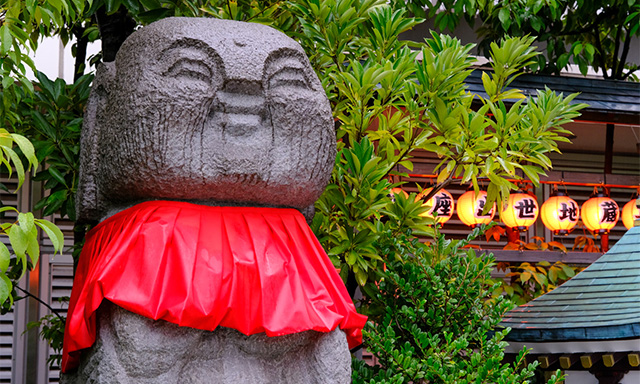
- Uino
- That lucky smile, along with the wide sky and green lawn is encouraging. It gives you the feeling that your fortune will get increasingly better. But there is an idea unique to Japan that the Jizo Bosatsu is actually the Great King Yenma. In a way, both the Jizo Bosatsu and Great King Yenma seem to carefully observe us before saving or judging us.
- Ogikubo
- In the past, the roadside and village entrances were ideal places to observe and guard people. In that sense, the rooftop may be just the right place to oversee the people of Ginza today.
- Uino
- Even this gentle Shusse Jizo may get angry if we take too much advantage of its smile.
- Ogikubo/Uino
- Let us join ours hands in prayer once again.
All List
- 2020.05.01 Visit Ginza’s Inari Shrines Vol.2 Asahi Inari Shrine
- 2020.08.01 Vol.3 Exploring Ginza in the Edo Period on an old map
- 2020.11.01 Visit Ginza’s Inari Shrines Vol. 4 Kakugo Inari Shrine
- 2021.02.01 Visit Ginza’s Inari Shrines Vol. 5 Azuma Inari
- 2021.05.01 Visit Ginza’s Inari Shrines Vol.6 Kabuki Inari
- 2021.08.01 Visit Ginza’s Inari Shrines Vol.7 Ginza Inari in Ginza 2-chome
- 2021.11.01 Visiting Ginza’s Shrines Vol. 8 Kumagai Inari Shrine
- 2022.02.01 Visit Ginza Shrines Vol. 9 Saiwai Inari Shrine
- 2022.05.01 Visit Ginza’s Shrine Vol. 10 Mimeguri Shrine and Shusse Jizoson on the roof of Mitsukoshi Department Store
- 2022.08.01 Visit Ginza’s Shrines Vol. 11 Komparu Inari
- 2022.11.01 Visit Ginza’s Inari Shrines Vol.12 Mankin Ryujin Seiko Inari Shrine
- 2023.02.01 Visit Ginza’s Shrines Vol.13 Hachikan Shrine
- 2023.05.01 Visit Ginza’s Inari Shrines Vol.14 Hoju Inari Shrine
- 2023.08.01 Visit Ginza’ Inari Shrines Vol. 15 Ryuko Fudo-son
- 2023.11.01 Visit Ginza’s Shrines Vol. 16 Hodo Inari Shrine
- 2024.02.01 Visit Ginza’s Shrines Vol. 17 Toyoiwa Inari Shrine
- 2024.05.01 Visit Ginza’s Inari Shrines Vol. 18 Yasuhira Shrine
- 2024.08.01 Visit Ginza’s Inari Shrines: Final Edition









